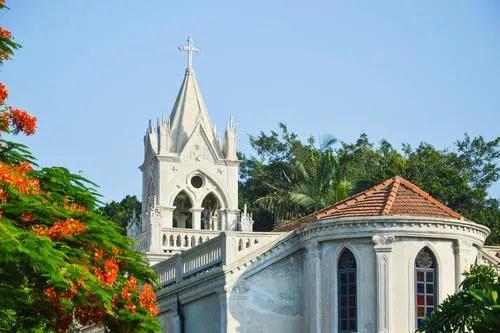Gulangyu is a pearl on the southeast coast of China, and has a white building at the top of the Gulangyu Deer Reef that is quite striking. That building is the Gulangyu Cathedral, which is not only one of the core elements of the world cultural heritages, but also a place for visitors to Gulangyu, and a place where many newcomers leave precious images. So, what are the stories of this small and elegant church?
As early as the end of the Ming Dynasty, the Catholic Church entered Xiamen and the preacher Li Koro even became Zheng Chenggong's successful "foreign envoy." But the real development is still in the modern period. In 1842, Dominic Lin Francis preached in Gulangyu. He was the first Catholic missionary to enter Xiamen in modern times.
Since then, Catholicism has taken root in Gulangyu. The establishment of the Catholic Church of Gulangyu is inseparable from a Spaniard who is a Dominican preacher, Manuel Prat.
Manuel Prat was born in Groner, Spain, in 1873. When he was young, he was determined and willing to serve the Lord for all of his life. At the age of 15, he joined the Spanish Dominion. After 9 years of monastery experience, he was anointed a priest by the Dominion.
In 1897, Manuel Prat was sent to Manila to preach, then the following year he went to Taiwan. In order to better preach the Gospel to the local people, he studied the Hakka language very hard. Manuel Prat first preached in Danshui. In 1903, he became a priest of the Luolu Church in Changhua, Taiwan. Here, in addition to preaching, Father Prat also paid attention to the cultivation of native preachers. In 1905, a missionary school was established next to the Church of Luolu.
In 1913, Taiwan was withdrawn from the diocese of Minnan, for the establishment of a pastoral area. The northern parish of Xinghua (comprising Yutian and Xianyou, two counties) was assigned to the pastoral area of the Southern part. Later, the south-north division was abolished, and the bishop's residence was changed to the diocese's name, known as Xiamen Parish. In 1916, Prat left Taiwan to become bishop of Xiamen.
Manuel Prat moved the former Bishop's Church in Xiamen's Ci An Road to Gulangyu. He swapped the building of a Dominion Club house in Gulangyu with the French Consulate and changed the consulate into the Bishop's Building. In front of the Bishop's Building, a cathedral was built in typical Gothic building style, designed by a Spanish architect.
The cathedral faces the southeast, with a floor area of 232 square meters and a masonry structure. The front part has a bell tower, with three floors. The first floor is for the entrance, the second serves as the choir-loft, and the third floor houses the bell clock. The middle and rear parts are single-storey, with the middle being a worship hall, and the rear an altar. The cathedral's platform is the simplest of the early Basilica style, comprising four pointed arches forming the main hall, a Latin cross, and an altar on the north side.
The outer look of the cathedral is mostly dominated by Gothic minarets, with pointed arched windows, facade decor, door-to-door windows. The crenelated parapet walls are also pointed. Due to the small size of the cathedral, the garden at the entrance is also quite small.
The windows are engraved with the following words in Chinese "God's Church" and the Latin words "ECCLESIA CATHOLICA" (meaning "Catholic Church"). It is the only surviving Gothic church in Xiamen, and is also the cathedral of Xiamen diocese.
Its capacity is 200-300 people. Because of it mostly serves as a place for worship of the Lord Jesus, it is called the "King Jesus" church, but commonly known as Gulangyu Catholic Church.
Manuel Prat raised the Xiamen Diocese for nearly 30 years. By the end of the 1940s, the diocese had 16,588 worshippers, 28 churches and 86 gathering points in Minnan. In addition, there were a total of 45 schools at all levels, 1 hospital, 2 clinics and 3 nursery halls. Bishop Prat still attached great importance to the cultivation of local priests in Minnan, and he founded a public school in Baishui Camp, Zhangzhou. He also annointed many Chinese priests; Zheng Shiguang, Mu Zishan and other famous priests were anointed by him.
In order to improve the scientific and cultural knowledge of the local people, the Protestant churches in Xiamen had opened schools. Manuel Prat was not willing to be behind, he established Weizheng Primary School in 1920 near the Catholic Church in Gulangyu and served as the principal. In 1935, Weizheng Primary School officially registered and filed for permission from the National Government, arranging two faith classes per week, and attendance of Mass on Sundays.
In 1946, Pope John XII declared the Chinese Church to be part of the holy system. Xiamen Diocese was upgraded from a pastoral area to a main diocese and Manuel Prat became its first bishop. In 1947, Bishop Manuel Prat was laid to rest in Gulangyu.
Prat's successor was Bishop Mao Zhongjuan. After 1949, Mao Zhongxuan and other Western missionaries were deported to their home countries. On September 5, 1953, representatives of priests, nuns and parishioners of Xiamen Diocese elected Huang Ziyu, a native priest, as acting bishop. During the Cultural Revolution, Gulangyu's cathedral was occupied as and turned into a factory.
It was returned to the Church in 1981 and reopened on 10 January 1982 after maintenance.
- Translated by Charlie Li










